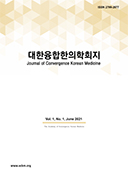3권 1호
초록
Abstract
Objectives: Smoking had a long negative impact on public health. The ingredients of a cigarette are major risk factors for several diseases. Owing to the problems about economic and quality of life, we need to ensure smoking cessation (SC). There are several approaches for SC including pharmacological therapy, nicotine replacement therapy, education, and behavioral intervention. However, due to some limitations, other alternative approaches are gaining popularity. Acupuncture has been reported to have few side effects and be more effective than some conventional treatments in several articles. However, there are no systematic reviews on the comparison of acupuncture combination treatment with other conventional monotherapies. Methods: Randomized controlled trials that used acupuncture as an adjunct treatment for SC will be searched and data will be summarized according to the predefined criteria. The primary outcome will be the abstinence rate, and secondary outcomes will be adverse events and biochemical indicators. We will use Review Manager to perform a meta-analysis, Cochrane Collaboration Risk of Bias tool for the risk of bias assessment, and the Grades of Recommendation, Assessment, Development and Evaluation approach to determine the quality of evidence. We will investigate the efficacy and safety of acupuncture combination treatment for SC with this study. Ethics and dissemination: This study will provide reliable clinical evidence on additional effect of acupuncture on smoking cessation. We will publish our results in a peer-review journal.
초록
Abstract
Objectives: This study was conducted to review the overall concept of nutritional evaluation of infants and young children. Methods: Literature search was done to study definition, method and importance of nutritional evaluation of infants and young children. Pubmed and Google scholarship were used in the research. Search words were 'Nutritional evaluation', 'infants' and 'young children'. Results: Nutrition evaluation is mainly used by physical measurement, clinical evaluation, dietary intake survey, and biochemical test depending on the age and disease. The treatment method for 治未病, which is a concept of korean medicine, and 健兒法 for treating the concept of weak children are considered to have very high applicability in solving various problems found through nutrition evaluation in korean medical approach. Conclusion: Infants and children are the fastest growing period of their lives, showing rapid growth in physical, and emotional development along with rapid brain growth. Therefore, inadequate nutrition during this period affects mental and physical growth and development not only during that period but also throughout life. Nutrition evaluation is divided into regular evaluation that includes children in all growing seasons and screening evaluation for problem solving, and follow-up nutritional evaluation that evaluates nutritional status in the long run. For each nutritional evaluation, evaluation is conducted by physical measurement, clinical evaluation, dietary intake survey, and biochemical test. By comprehensively interpreting them, nutritional status is determined. This study provides basic data on the proper nutrition evaluation method to identify and correct nutritional problems such as growth level, nutritional deficiency, and nutritional excess early.
초록
Abstract
Objectives : The purpose of this study is to investigate the effect of Sa-am acupuncture and Moxibustion on urgency by Overactive bladder in a 79-year-old female patient who has undergone Tension-free Vaginal Tape (TVT) operation. Methods : Patient was treated with Sa-am acupuncture on four acupoints including 太淵(LU9), 太白(SP3), 魚際(LU10) and 少府(HT8) and Moxibustion on two acupoints including 水道(ST28) and 中極(CV12). Patient's symptom was assessed Overactive Bladder Symptom Score(OABSS), Bladder diary and King's Health Questionnaire (KHQ). The treatment was executed once everyday from June, 13th to June, 22th of 2017. Patient was observed from June, 11th to June, 22th. Results : After ten sessions of Sa-am acupuncture and Moxibustion, patient's urinary symptoms were evaluated by OABSS, Bladder diary, and KHQ. After the treatment, total OABSS score decreased from 9 to 5. The frequency of Urgency decreased from 4 to 1. The Urgency grade decreased 4~5 to 1. The mean number of pad changing decreased 3.5 to 1. The score of Role Limitations, Physical Limitations, Social Limitations, Emotions in KHQ decreased. Conclusions : The results suggest that Sa-am acupuncture and Moxibustion can be a valuable option in treating urgency by OAB.

